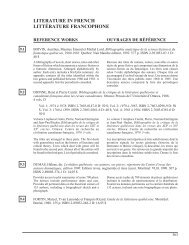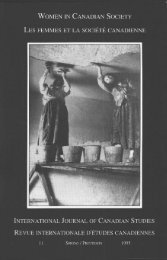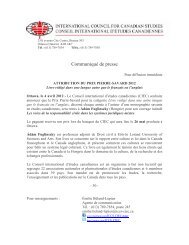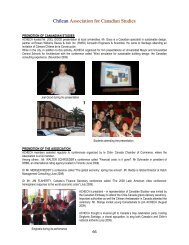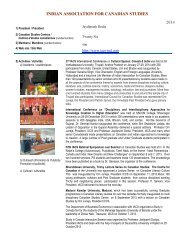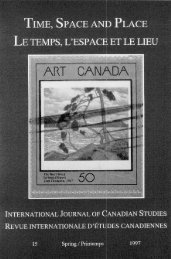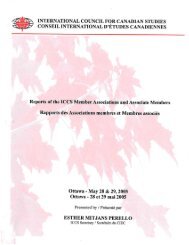Arts and Literature in Canada:Views from Abroad, Les arts et la ...
Arts and Literature in Canada:Views from Abroad, Les arts et la ...
Arts and Literature in Canada:Views from Abroad, Les arts et la ...
- No tags were found...
Create successful ePaper yourself
Turn your PDF publications into a flip-book with our unique Google optimized e-Paper software.
IJCS/RIÉCUnlike Christa Wolf, for whom memory is “a repeated moral act” (MC 143),Alice Munro does not see memory as a moral imperative. Instead, <strong>and</strong><strong>in</strong>creas<strong>in</strong>gly so as her work progresses, she sees it as a creative force,composed both of reproductive memory as a rich m<strong>in</strong>e of material <strong>and</strong> creativememory with its shap<strong>in</strong>g power. In her essay “The Colonel’s Hash Res<strong>et</strong>tled”Munro exp<strong>la</strong><strong>in</strong>s how she employs memory, with reference to her short story“Images” (Dance of the Happy Shades):It has actually become difficult to sort out the real memories [...] used<strong>in</strong> this story <strong>from</strong> those that are not ‘real’ at all. I th<strong>in</strong>k the others arereal because I did not consciously p<strong>la</strong>n, make, or arrange them; Ifound them. And it is all deeply, perfectly true to me, as a dreammight be true, <strong>and</strong> all I can say, f<strong>in</strong>ally, about the mak<strong>in</strong>g of a storylike this is that it must be made <strong>in</strong> the same way our dreams are made,truth <strong>in</strong> them be<strong>in</strong>g cast [...]. 26After giv<strong>in</strong>g a concr<strong>et</strong>e example of her creative process, Munro cont<strong>in</strong>ues:“Now I distrust the way I used the word remember [...]. I could have said<strong>in</strong>vent; the k<strong>in</strong>d of remember<strong>in</strong>g I mean is what fictional <strong>in</strong>vention is.” 27Munro has used memory material <strong>from</strong> the outs<strong>et</strong>, especially <strong>in</strong> her first personnarration. In the short story, “The Peace of Utrecht,” the act of remember<strong>in</strong>g isfor the first time rendered by means of m<strong>et</strong>afiction, with the first personnarrator reflect<strong>in</strong>g on the process of reproduc<strong>in</strong>g d<strong>et</strong>ails of her recollected past.From Lives of Girls <strong>and</strong> Women onward, Munro has perfected heridiosyncratic technique of render<strong>in</strong>g memory material. Y<strong>et</strong>, be<strong>in</strong>g an <strong>in</strong>tuitiverather than an analytical artist, Munro seems to feel uneasy about an<strong>in</strong>terpr<strong>et</strong>ation that sees created memory as a conscious technique <strong>in</strong> her workSo, when persistently questioned by Kay Bon<strong>et</strong>ti on this po<strong>in</strong>t, Munro rema<strong>in</strong>snon committal until she f<strong>in</strong>ally concedes <strong>in</strong> her typically modest, hesitant way:“[...] though <strong>in</strong> the <strong>la</strong>st book I did see that this memory th<strong>in</strong>g was certa<strong>in</strong>lycom<strong>in</strong>g out very strong — <strong>and</strong> I hadn’t thought about mak<strong>in</strong>g it do that.” 28Del Jordan, like her German counterpart, is endowed with an extraord<strong>in</strong>arymemory. Y<strong>et</strong>, unlike Nelly, she feels no qualms about demonstrat<strong>in</strong>g it,embark<strong>in</strong>g on her story with great gusto, reproduc<strong>in</strong>g the most d<strong>et</strong>aileddescriptions of people <strong>and</strong> p<strong>la</strong>ces, as well as lengthy dialogues, <strong>from</strong> days longpast. Y<strong>et</strong> she, too, resorts to documentary evidence, try<strong>in</strong>g to trace the privatefamily history <strong>in</strong> her community’s “public history,” <strong>in</strong> Uncle Craig’s oral <strong>and</strong>written reports. Apart <strong>from</strong> substantiat<strong>in</strong>g memory by documentary evidence,Munro makes her narrator reflect on the genesis of her recollections. In th<strong>et</strong>hird section of the novel (“Pr<strong>in</strong>cess Ida,” a chapter dedicated to Del’s mother),the narrator juxtaposes Ada Jordan’s <strong>and</strong> Uncle Bill’s (Ada’s brother’s)widely diverg<strong>in</strong>g childhood memories. Brother <strong>and</strong> sister have radicallydifferent recollections of their mother, a discrepancy that leaves the child Delbewildered <strong>and</strong> deeply doubtful about the reliability of adult people’s stories.Del beg<strong>in</strong>s to distrust her mother’s eloquence, her references to po<strong>et</strong>ry, her78



